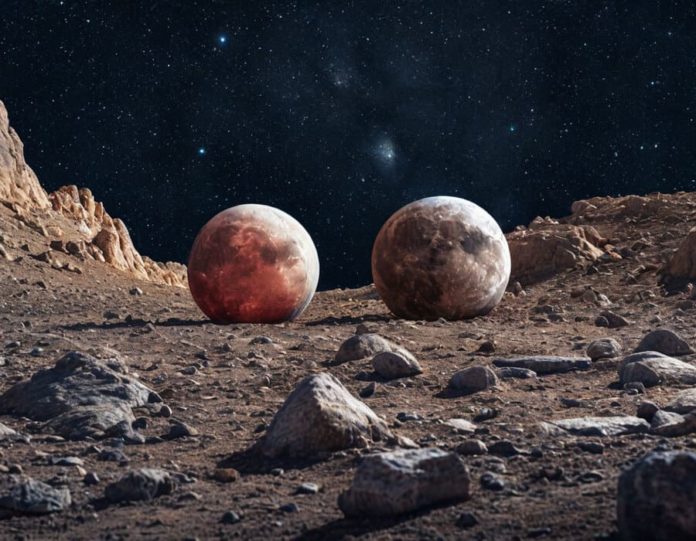Mars’ moons, Phobos and Deimos, have long intrigued scientists, not just for their mysterious origins but also for their potential role in future space exploration. These small, irregularly shaped bodies could hold the key to unlocking new strategies for exploring Mars and beyond. Let’s dive into what makes Phobos and Deimos so interesting and how they might play a part in humanity’s next steps in space.
The mystery of Mars’ Moons
Phobos and Deimos are unlike Earth’s moon in several ways. For starters, they are much smaller—Phobos is about 22 kilometers (14 miles) in diameter, while Deimos is even tinier at about 12 kilometers (7.5 miles). Their irregular shapes and cratered surfaces suggest that they might not have formed alongside Mars but could instead be captured asteroids or remnants of a larger body that broke apart.
The exact origins of these moons are still debated, but understanding them could provide valuable clues about the history of the Martian system and the broader processes at work in our solar system.
Why Mars’ Moons matter for exploration
While Phobos and Deimos might seem like small, insignificant bodies compared to Mars itself, they offer several potential advantages for future missions:
- Staging points for Mars missions: One of the biggest challenges of exploring Mars is the planet’s gravity well. Landing and launching from Mars requires significant energy. However, Phobos and Deimos have much weaker gravity, making them easier to reach and depart from. They could serve as bases or “pit stops” for missions to Mars, allowing spacecraft to refuel, resupply, or even assemble before heading to the Martian surface.
- Scientific exploration: The moons themselves are valuable scientific targets. Studying their composition could reveal more about the early solar system and the processes that shaped it. If they are captured asteroids, analyzing their material could provide insights into the building blocks of planets. Additionally, understanding the surface conditions of these moons can help prepare for future exploration of other small bodies in the solar system, like asteroids or moons of the outer planets.
- Resources for future missions: Phobos and Deimos might also offer resources that could be utilized by future explorers. For example, their surfaces may contain water ice or other materials that could be mined for fuel, life support, or construction. This concept, known as in-situ resource utilization (ISRU), is a critical aspect of sustainable space exploration.
Potential missions to phobos and deimos
Several mission concepts have been proposed to explore Mars’ moons, each aiming to unlock their secrets and assess their potential for aiding future exploration.
- MMX (Martian Moons eXploration): The Japan Aerospace Exploration Agency (JAXA) is leading the MMX mission, scheduled for launch in the mid-2020s. The mission aims to land on Phobos, collect samples, and return them to Earth for analysis. MMX will provide the most detailed study of Phobos and Deimos to date, offering insights into their composition and origins.
- Human missions: NASA and other space agencies have considered the idea of sending astronauts to Phobos or Deimos as a precursor to Mars surface missions. Such missions could test technologies, study the moons up close, and offer a safer, lower-risk alternative to landing on Mars itself. Astronauts could even remotely operate rovers on the Martian surface from the moons, avoiding the communication delays caused by the distance between Earth and Mars.
- Orbital stations: Another idea is to establish orbital stations around Phobos or Deimos. These stations could serve as hubs for robotic or human exploration of Mars, offering a place to repair and maintain spacecraft, store supplies, and coordinate missions.
The challenges and opportunities
While the potential benefits of exploring Phobos and Deimos are significant, there are also challenges. The low gravity of these moons makes landing and operations tricky, as traditional techniques used on larger bodies like the Moon or Mars might not work. Dust and debris on their surfaces could pose hazards to spacecraft, and the moons’ proximity to Mars means they are exposed to high levels of radiation, which could affect both human explorers and robotic systems.
However, the opportunities outweigh the challenges. Phobos and Deimos represent a unique opportunity to explore the Martian system in a way that could greatly enhance our understanding of Mars and facilitate future missions. By leveraging these moons, we could develop new strategies for sustainable exploration, not just of Mars but of other planets and moons in our solar system.
Mars’ moons, Phobos and Deimos, may be small, but they could play a big role in the future of space exploration. Whether as stepping stones to Mars, scientific targets, or sources of valuable resources, these enigmatic moons offer opportunities that could shape the way we explore the Red Planet and beyond. As missions like JAXA’s MMX get underway, we’ll likely learn much more about these moons and their potential to unlock new frontiers in space.













